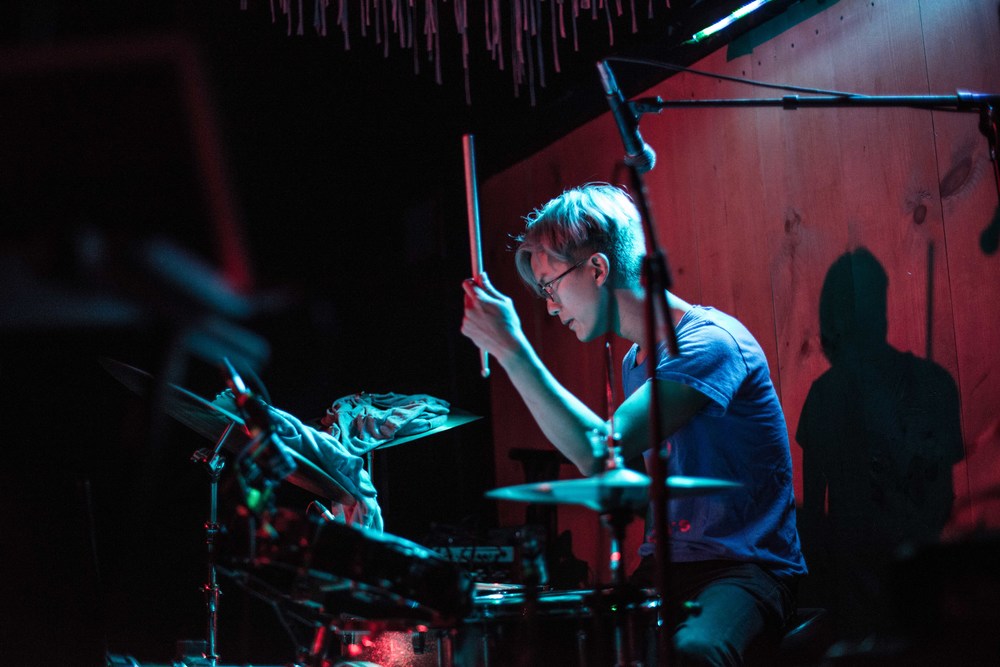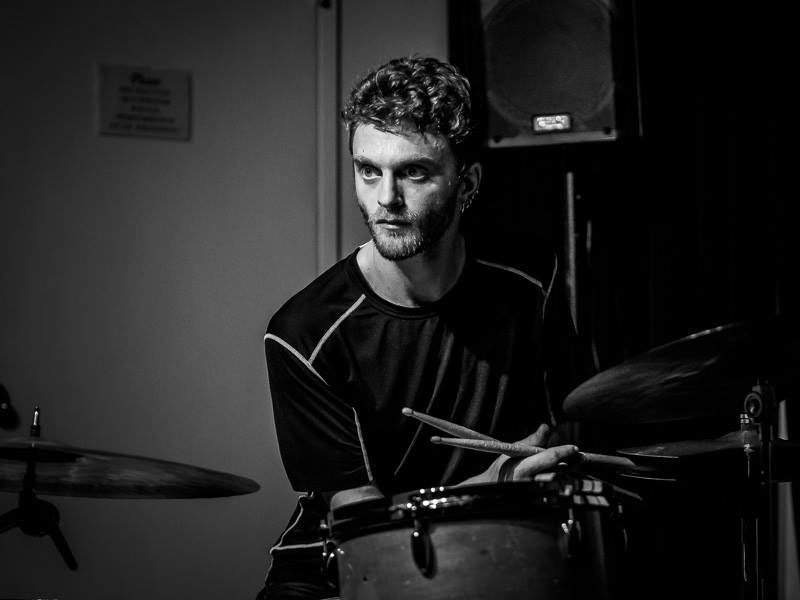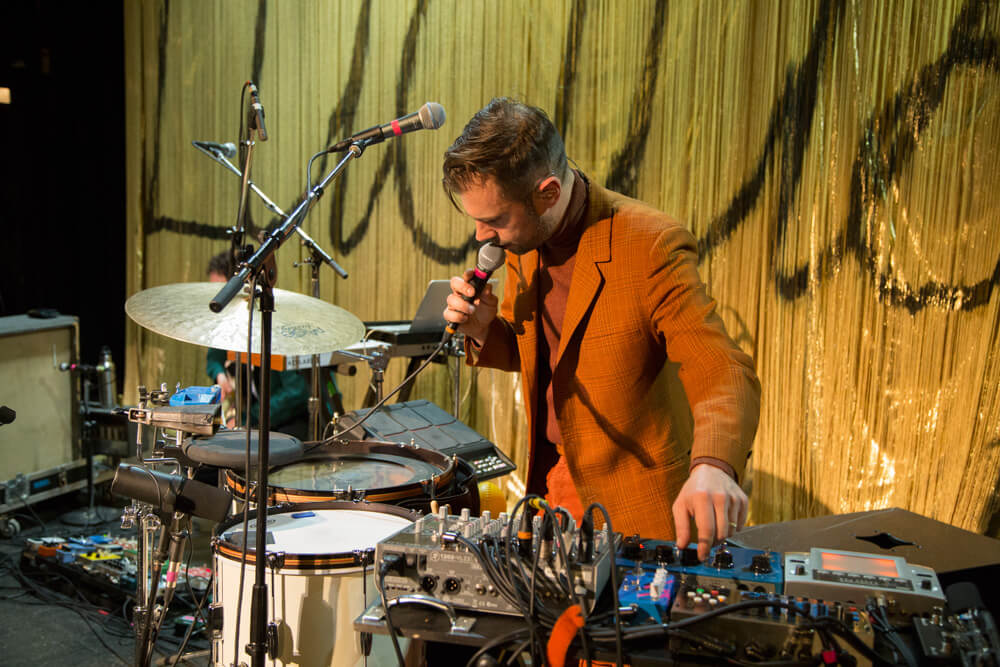+ Learn to craft more compelling beats and warped, broken rhythms with Son Lux’s Ian Chang. His innovative course is out now on Soundfly.
Whether you’re sitting down to a jazz concert, flipping out at a death metal concert, or standing around to watch a group of indie darlings, towards the back of the stage you’re almost always guaranteed to see a drum kit. Rhythm is one of the great unifiers in music and there’s nothing quite like watching a live drummer hammer the skins.
So when drummers are also able to coax vast worlds of sound and tone to accompany the barrage of beats, it becomes even more exciting. We’ve been following the incorporation of electronic elements in drum kits for a long time, and it’s taken a bunch of forms, but these days both the innovations and the artists implementing them are reaching new heights.
Here are four of our favorite drummers today making use of cyborg sets to create some of the coolest, genre-defying music around.
Ian Chang (of Son Lux, Landlady)

What he uses: Sensory Percussion.
Sensory percussion turns any single drum into a multi-sampler. The Sunhouse Sensory Percussion tool is much more than a drum trigger; it turns a single drum into an infinite world of electronic sound parameters, effects, and options. Ian Chang says, “It translates the physicality of drumming into whatever customizable, sonic environments you want want to create.”
Players first “train” the sensor to pick up the different timbres and location fields of different hits. “The sensor picks up all those nuances and turns them into whatever you want them to be.” For example, a rim shot will play a different sample than a straight hit or a drum roll (and the center of the drum head will produce a different sound than say, hitting the rim or shell of the drum, or even just the sides).
There are 10 total zones you can play and the zones can either blend into each other seamlessly or remain separate with hard cut-offs. This allows a single tom or snare to become a multi sampler that, unlike the Mandala pad, you can incorporate 10 distinct sounds rather than just a filter range or effect.
And just like his band mate in Son Lux, Ryan Lott, Ian Chang has a new online course out on Soundfly that breaks down and demystifies his process, and teaches his grandest pieces of advice for creating more compelling beats with abstract rhythms and warped beats. But don’t forget to check Chang out in this video about how the Sunhouse technology works.
Danny Carey (of Tool)

What he uses: Pads, specifically Synesthesia Mandala pads, which he developed.
Already drumming at crazy elevations, Danny Carey uses his Mandala drum pads to bring his sound to new, creative heights. It has 128 strike-position detection rings from its center out to its edges, along with 127 levels of velocity sensitivity. In its current iteration, mk2.9, both values are transmitted via USB MIDI to a computer, where they can be interpreted by any MIDI software.
For practical playing, the pad can be concentrically divided into as little as one or as many as six playing zones via its Virtual Brain software. The individual zones, position rings, and velocity levels can be used to trigger different instruments, effects parameters, or volume changes. Any parameter of any effect can be set to the velocity or the position. For example if you wanted to affect the pitch of a drum, the software would allow you to have it play higher when you hit it more towards the middle, higher as you hit it towards the outside, or you could match pitch to the velocity.
Greg Fox (of Zs, Liturgy, Guardian Alien)

What he uses: A wide variety of electronic drums and sensory percussion.
A lot of Greg Fox’s solo music is much more complex than one would expect from a live drummer. He has made algorithmic music based on his heart rhythms, with technology invented by jazz drummer and healer Milford Graves, and you can see in the video below he has also played the wonderful Bastl Modular synth using a series of drum pads. The pads and modular synth allow him to play a fully realized electronic song with a bass line, drums, and even lead effects for a very jammy track.
Fox also uses a Sensory Percussion module. At this point, Fox has begun using it alongside his entire kit, but during a long incubation period as he grew into the tech, he performed a whole live set using just a snare drum. It’s a fantastically creative way to make unexpected music from a single drum, and it remains interesting musically the entire time. The Sensory Percussion module allows him to incorporate melodic elements to drumming.
Danny Molad (of Lucius)

What he uses: Live loops and triggers.
Many drummers will often eschew using triggers, choosing instead to play along to a track. This means one less thing to think about while they perform. “A lot of people, after they make a record like that, will immediately go to something like Ableton, Logic, or Mainstage, and be like, ‘Okay, let’s get our tracks, and whatever we can’t play, the computer will play,’ but we didn’t want to do that,” Molad says in an interview with Shure. “That’s why we did live looping because it creates an element of chance. There’s a possibility that I’m going to do something wrong or play it a little differently than I did the night before, and it’s always a little nerve-wracking and exciting. I feed off that kind of energy of not knowing if it’s going to go right every night.” Lucius’s electric live shows have been lauded as some of the most energy-filled music happening today.
Using live loops is a great way to mix organic and processed sounds. You can hear the signature mix of acoustic and electric drums in their 2016 release, Good Grief. Live looping and the element of chance help to create that energy both in the studio and on the stage.
Keep on Grooving…
Continue your learning with hundreds of lessons on songwriting, mixing, recording and production, composing, beat making, and more on Soundfly, with artist-led courses by Kimbra, Com Truise, Jlin, Kiefer, RJD2, and our new The Pocket Queen: Moving at Your Own Tempo.




